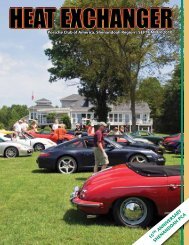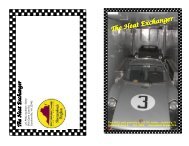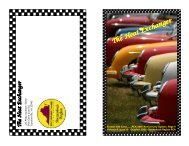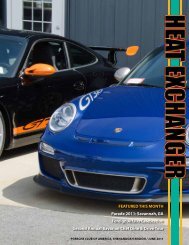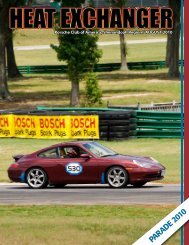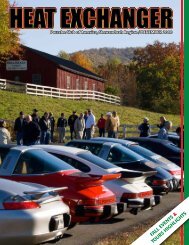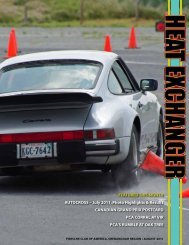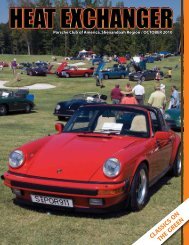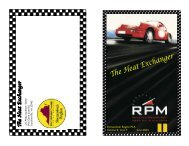Porsche Club of America, Shenandoah Region / APRil 2010
Porsche Club of America, Shenandoah Region / APRil 2010
Porsche Club of America, Shenandoah Region / APRil 2010
You also want an ePaper? Increase the reach of your titles
YUMPU automatically turns print PDFs into web optimized ePapers that Google loves.
911 Rear Suspension Rebuild continued from pg 14<br />
onto both the spring plate and the spring plate cover.<br />
After letting the primer dry overnight, I painted the spring plate<br />
with Silver Cad spray paint. I used Gold Cad spray paint on the<br />
spring plate cover and then followed with a clear overspray. I<br />
was amazed; the two parts looked like new! I set the parts aside<br />
to dry.<br />
Now we are getting to the real purpose <strong>of</strong> all this prep work…<br />
the installation <strong>of</strong> new bushings and setting the rear suspension<br />
height.<br />
I placed the new bushings in my freezer to get them nice and<br />
“hard”. The cold, hard rubber will slide easier when pressing<br />
them into position on the spring plate. While the bushings were<br />
cooling, I removed the tape from the spring plate and cleaned<br />
the bare metal areas with solvent. Now you are ready to glue<br />
the new bushings into position on the spring plate. There is<br />
some debate as to whether to use glue or not. The instructions<br />
that come with the new bushings say to glue them in place, so<br />
that is what I did. I used Loctite super glue, instead <strong>of</strong> the glue<br />
supplied by Neatrix. You do not need much and you do not<br />
want to get any glue on the outer surface <strong>of</strong> the new bushing.<br />
The new bushings are all the same size, so there is no chance<br />
<strong>of</strong> mixing them up. I did one side <strong>of</strong> the spring plate at a time;<br />
apply the glue and slide the new bushing into place. If you have<br />
resistance pressing the new bushing into position, you may want<br />
to use a small block <strong>of</strong> wood and a mallet to tap the bushing<br />
into position. You want to get the inside <strong>of</strong> the bushing flush up<br />
against the spring plate. Do the other bushing and set the “new”<br />
spring plate aside to let the glue dry.<br />
the gory details, but you first insert the torsion bar back into<br />
the body, slip the spring plate over the outer end <strong>of</strong> the t-bar,<br />
and set the spring plate at a 20-degree droop angle. After<br />
pushing the inner spring plate bushing into the body cavity and<br />
engaging both the inner and outer splines <strong>of</strong> the torsion bar, the<br />
spring plate should be firmly in position and have no vertical<br />
movement. Measure the spring plate’s droop angle and adjust<br />
the angle as needed. Angle adjustments are made by indexing<br />
the spring plate relative to the position <strong>of</strong> the inner and/or outer<br />
torsion bar splines. This is really an easy process, but you need<br />
a good angle finder and a bit <strong>of</strong> patience.<br />
Once I got the spring plate droop angle set, I installed the spring<br />
plate cover. The silicone grease will facilitate the re-assembly<br />
process because the new bushings will have a snug fit. I was<br />
able to hand press the spring plate cover into a position where<br />
I could get the original bolts to start threading into the body.<br />
Tightening at alternating corners, I installed the spring plate cover<br />
back into position. Do not forget the spacer that fits between<br />
the cover and the body on the lower rear bolt. If your cover’s<br />
fit is really tight, you may need to get a couple <strong>of</strong> longer bolts<br />
to pull the cover into a position where you can then use the<br />
original bolts to snug it into place.<br />
Use the floor jack to raise the trailing arm and spring plate; you<br />
will need to make small adjustments to the jack height as you<br />
re-install the hardware. Install the toe and camber eccentric<br />
bolts and their nuts; orient the bolts based on the markings you<br />
made during disassembly (the 22 mm allen wrench will help<br />
with this step). Install the two trailing arm bolts and finally the<br />
lower shock bolt. Make sure all nuts and bolts are torqued to<br />
<strong>Porsche</strong> specs…we do not like suspension parts falling <strong>of</strong>f at<br />
speed!<br />
At this point, I moved over and did the other side <strong>of</strong> the car.<br />
Follow the same steps; the process will go smoother and<br />
faster because you are now “experienced” at rebuilding rear<br />
suspensions.<br />
THE END IS IN SIGHT! When both sides were done, it was<br />
time for the moment <strong>of</strong> truth. I re-installed the wheels, but<br />
left the rocker panels <strong>of</strong>f for now. I let the car down from the<br />
jack stands and measured my ride height. I was a higher than<br />
I wanted, but I had not settled the suspension yet. I took the<br />
car out for a 30-minute spin in the country to settle everything.<br />
The rear end felt tight, rode like a dream and no squeaks! Back<br />
in the garage, I measured my new ride height and BINGO…<br />
it was right on the money. I had raised each side 2.5 degrees,<br />
which equates to roughly a ½” increase in rear ride height. Wil<br />
Ferch’s angle calculator I mentioned earlier worked like a champ.<br />
Additionally, the car now has a 1-degree nose down sweep.<br />
angle finder<br />
It was now time to put it all back together and set my new<br />
rear suspension height. I used Wil Ferch’s “911 Spring Plate<br />
Angle Calculator” that is located on this web site: HYPERLINK<br />
"http://rennlight.com" http://rennlight.com<br />
This web site also has a tech article with pictures that describes<br />
much <strong>of</strong> the work featured in this article.<br />
I have 28 mm rear torsion bars and I wanted to set the height<br />
to low “Euro” height. Using the calculator, my target spring<br />
plate angle was 24 degrees. If you recall, my car was resting at<br />
4 degrees nose down, so I needed to set my measured spring<br />
plate angle at 20 degrees.<br />
Before positioning the spring plate back into the car, I covered<br />
the exterior <strong>of</strong> the new bushings with Dow-Corning 112 silicone<br />
grease to facilitate re-assembly. I am not going to go into all<br />
I jacked the car back up and re-checked the torque settings<br />
on all nuts/bolts. I re-installed the torsion bar cover plate and<br />
rocker panels and put the car back on the floor. I recommend<br />
having the car pr<strong>of</strong>essionally aligned after performing any<br />
suspension “surgery”.<br />
It is now time for the frosty malted beverage <strong>of</strong> your choice. Sit<br />
back and admire your handy work. Feels good to know you did<br />
it yourself.<br />
Let me close by saying this narrative is long. However, I wanted<br />
to write a detailed description <strong>of</strong> all the steps I went through<br />
for future reference and to share my experience with others. I<br />
also took pictures with my digital camera <strong>of</strong> the various steps<br />
described in this narrative; pictures also help if you do an<br />
“OOPS” and need to correct your error.<br />
Happy Motoring!<br />
HEAT EXCHANGER 4.<strong>2010</strong><br />
16



